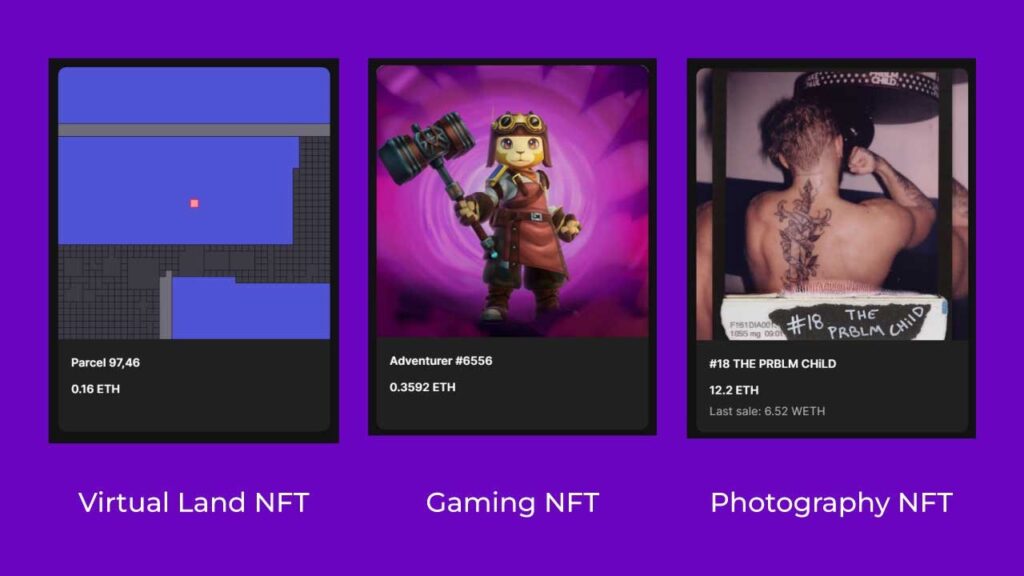NFTs have gained widespread attention and adoption across various industries, including art, music, gaming, collectibles, and virtual real estate.
According to industry reports, the total value of NFT transactions surged to billions of dollars in recent years, with record-breaking sales of individual NFTs reaching millions of dollars.
This tech has provided the options to make money for people, in a few legit ways and mostly by scamming.
And in this article, we are gonna talk about those legit ways.
Caution: This article is for informational purposes only and does not constitute financial advice. Always do your own research.
Before getting into the money making part, let’s make sure you understand what NFTs aka Non-fungible Tokens are, and how they work.
NFTs are unique digital assets that represent ownership or proof of authenticity of a specific item or piece of content, recorded on a blockchain.
Unlike cryptocurrencies such as Bitcoin or Ethereum, which are fungible and can be exchanged on a one-to-one basis, NFTs are one-of-a-kind and cannot be replicated or replaced.
Each NFT contains metadata that provides information about the asset it represents, such as its creator, date of creation, and any associated licenses or rights.
NFTs have revolutionized the concept of ownership in the digital realm, enabling creators to tokenize their work and monetize it directly, while providing collectors with a secure and transparent way to buy, sell, and trade digital assets.
Note that NFTs exist on different blockchains like Ethereum, Solana, etc. and the file types can be JPEGs, Music Files, Videos, etc.
And the use of blockchain technology ensures the scarcity, provenance, and authenticity of NFTs, making them valuable as digital collectibles, artworks, in-game assets, and more.

There are only 2 ways. Sell. or Create.
Currently, there are tons of NFT collections out there. When investing in NFTs, what you need to consider is the utility or the status each NFTs provides.
Just because some NFT collection has 10k PFP NFTs, doesn’t make it valuable.
Punks are valuable because they are the first, and Apes are valuable because of their strong community and brand (many celebs own Ape NFTs).
Because the core value of NFTs is their uniqueness, collecting them is a lot like collecting art or a moment that you are well connected with.
And because these digital “collectables” are one of a kind, they can be sold for profit just like any physical piece of art or a baseball card could be.
Ok, but what types of NFTs to invest in? What kind of NFT can turn out to be a profitable one?
Well, there is no exact answer to that, but here are some guidelines that you can follow.
Where do I buy these NFTs?
Platforms like OpenSea, Rarible, Foundation, and others provide a user-friendly interface for browsing, discovering, and transacting with NFTs across various categories and genres.
But the best ROI comes from buying the NFTs at a mint price, and then selling it for a higher price. Of course, factors like the Project’s value, holding period etc. matter on whether you’ll make a profit or loss.
For example, some people who minted a Bored Ape, had 1000% returns. Some people who had minted NFTs from collections like Evolved Apes ended up with a rug pull and 100% loss.
Ok, how do I buy these NFTs?
Buying and selling NFTs on these marketplaces typically involves connecting a digital wallet (such as MetaMask or Coinbase Wallet) to the platform, funding the wallet with cryptocurrency (e.g., Ethereum), and completing transactions using smart contracts (don’t worry, this happens behind the scenes on Marketplaces) on the blockchain.
And here is a beginner’s guide on how to buy NFTs.
What are the downsides of investing in NFTs?
Related Read: Where Do NFTs (Non-Fungible Tokens) Get Their Value
Related Read: 8 NFT Minting Tools (No Code) To Create NFT Collections Easily
NFTs present lucrative opportunities for artists and investors, but navigating the landscape requires caution amid potential scams and volatility.
With careful research and strategic engagement, individuals can harness the power of NFTs to redefine digital ownership and expression responsibly.